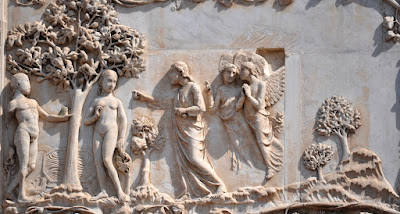Edward Hutton tells the story of Orvieto and its Cathedral in great detail. Here is the first of two posts.
D’Annunzio has well described Orvieto: “Imagine a rock in the middle of a melancholy valley, and on the top of the rock a city, so deathly silent as to give the impression of being uninhabited—every window closed—grass growing in the dusty grey streets—a Capuchin friar crosses a piazza—a priest descends from a closed carriage in front of a hospital, all in black, and with a decrepit old servant to open the door; here a tower against the rain-sodden clouds—there a clock slowly striking the hour, and suddenly at the end of a street, a miracle—the Duomo!”
Peace and silence: that is what the traveller will find in Orvieto, for far from the contemporary uproar she still dreams of the miracle of Bolsena which her Cathedral was built to commemorate. …
The Cathedral … is the most beautiful in Umbria, and the flaming façade is perhaps the loveliest in Italy. The church stands on a marble platform in a wide piazza. Facing it are the Palazzo Faina and the Palazzo dell’ Opera del Duomo, founded in 1359, with a great Baroque façade of the seventeenth century, then the Ospedale.
The glory of the Duomo is of course the façade, which was perhaps first imagined by Arnolfo di Cambio with but a single and central pediment or gable, but in 1310 the Sienese master, Lorenzo Maitani, gave it the three triangular pediments we see, and its marvellous colour and decoration in mosaic and sculpture, between 1327 and 1337; and his work was continued by Andrea Pisani, Orcagna and others till 1388. The uppermost story was added by Antonio Federighi of Siena (1444-90).
The sculptures in bas-relief on the façade were executed between 1310 and 1327, in part by Lorenzo Maitani and in part under his supervision. They belong therefore to the golden age of the art of Siena, the age of Duccio, Simone Martini and the Lorenzetti. They are perhaps the greatest achievement of the Sienese school of sculpture and are among the most lovely things in Italy. …
The whole story of the Creation and the Fall of Man is represented on this façade. A little conventionally, you might say, these Sienese artists deal with their art, and yet what pathos in that figure of Adam whom God approaches so eagerly, so graciously in the garden. The astonished angels wait, with how profound an agitation, for this new thing. And again, when that deep sleep fell upon our father, and God with blessing—for He does bless her—draws woman from his side, and two angels hesitate in the garden among the trees, the one seeming to tell the other of all that has gone before, when Adam lay a marvellous shape of dust waiting the touch of the finger of God; as you look on the sublime scene the picture of Michelangelo comes to you as he painted this very thing on the ceiling of the Sistine Chapel. There Adam, half alive, lies over the world and stretches out his finger—how languidly—to touch the finger of God; he is almost unconscious, still wrapped round by dreams, yet a touch of the finger-tips will suffice to awaken him to life itself, and all that God holds, woman and the future, in the fold of His garment. But here Christ is the chief figure in that act of creation, God the Father being represented by a hand, while the Holy Spirit in the form of a Dove with outspread wings hovers over the waters and the earth and the stars.
Sienese work though this is, there is energy and realism in that figure of Adam where he stands with Eve for a moment beneath the Tree of Knowledge, and God, with a kind of severity, forbids them to eat of that fruit. Eve listens with a curious meekness, an easy acquiescence. But Adam stands at his full height and looks God in the eyes as a beloved son, and really understands that this tree which he touched with his fingers bears the forbidden fruit. Here is a poem as noble as Milton’s Paradise Lost.
###
Edward Hutton: Assisi and Umbria Revisited, London, 1953. Pp. 131-134.




No comments:
Post a Comment